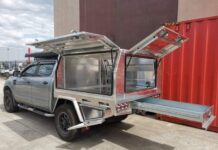You’re in the wild, surrounded only by the untainted beauty of nature and an overwhelming sense of freedom. As you take in the breathtaking scenery, you realize there’s more to this adventure than just admiring the view. To truly experience and conquer the great outdoors, you must know how to survive using only your wits and a trusty camping knife.
Your camping knife is about to become your best friend as it transforms from a simple cutting tool into a versatile lifesaver. In this article, we’ll guide you through various survival tactics where your camping knife plays an essential role – from building shelters and starting fires to crafting tools.
Building a Shelter
A well-built shelter protects from the elements and offers a sense of safety and security. Before you begin building your haven, take some time to choose an ideal shelter location – preferably one that is elevated, close to water, and has natural wind barriers such as trees or rocks.
Your camping knife will be essential for gathering materials and crafting your makeshift home. Use it to cut branches and vines to create the framework of your shelter. To ensure maximum warmth during those chilly nights, incorporate natural insulation by using your knife to collect leaves, grasses, or moss which can then be stuffed into clothing or used as bedding material. For this purpose, the best choice would be one of the automatic knives from Tektoknives. This insulation layer will help conserve heat and keep you comfortable throughout the night.
Starting a Fire
Igniting a roaring fire is the lifeblood of any wilderness adventure. With your trusty blade, you’ll stoke those flames in no time. A well-built fire provides warmth and a means to cook food and serves as a beacon for rescuers if you find yourself stranded. The first step to building your campfire is finding an appropriate site while keeping fire safety in mind. Choose an area free from overhanging branches or excessive dry vegetation and ensure that you have enough space to build and maintain the fire safely.
To get started, gather a kindling selection that will help ignite your fire quickly:
– Dry leaves: these are easy to find on the ground around most wooded areas.
– Small twigs: snap these off of branches or pick them up from the forest floor.
– Shavings or feather sticks: use your camping knife to shave thin curls from larger pieces of wood or make feather sticks by carefully carving into one side of a stick, creating multiple curled shavings attached at one end.
– Pine needles: if you’re near pine trees, their dry needles make excellent kindling material.
– Birch bark: this type of bark is rich in natural oils, which makes it an ideal choice for starting fires.
Once you’ve collected enough kindling, arrange it into a teepee shape with plenty of airflow between materials. Add progressively larger sticks around the teepee structure until you’ve built up a stable fuel source for your fire. Now comes the moment when your camping knife shines: use it to strike sparks onto a tinder bundle (a small cluster of fine plant fibers) or use its sharp edge with a ferrocerium rod (firestarter). The resulting sparks should catch on your tinder bundle, which can be placed amongst your carefully arranged kindling. Gently blow on it until all elements catch flame, and enjoy the warm embrace of your fire.
Crafting Tools and Utensils
Out in nature, nothing quite compares to the satisfaction of crafting your own tools and utensils with just a bit of skill and a trusty blade by your side. Whether whittling sticks for roasting marshmallows or carving out primitive pottery from clay, your camping knife is essential for thriving in the wilderness. With a bit of resourcefulness and creativity, you can fashion everything from eating utensils to a DIY compass using only what’s around you and your knife.
First things first – before tackling any survival project, make sure your camping knife is sharp and in good working condition. Once that’s taken care of, let’s start with something simple like creating wooden utensils. Find a sturdy branch or piece of wood at least an inch thick, then use your knife to carve out the rough shape of a spoon or fork. Smooth down the edges until it’s comfortable to hold and use. If you’re feeling particularly ambitious, try making some primitive pottery using clay found near rivers or streams. Shape it into bowls or cups with your hands, then carefully use your camping knife to refine the edges.
For navigation purposes, create a DIY compass using natural materials like a leaf and water along with some metal items like sewing needles or paper clips, which can be magnetized by rubbing against silk fabric or hair several times before placing it on top of the water for them to align according to North-South direction due Earth’s magnetic field influence (make sure they float freely). A sharpened stick can also serve as a fishing spear when needed – just split one end into multiple prongs using your camping knife. Hence, it increases the chances of catching fish once thrown towards them accurately within water bodies nearby campsite area(s).
Emergency Situations
When things go awry in the great outdoors, knowing that a trusty blade can rescue us in those precarious times of need is comforting. Your camping knife can be invaluable for handling emergencies, such as creating emergency signaling or providing wound care. For example, you can use your knife to carve out an SOS signal on a tree trunk or cut branches to create a signal fire, alerting others to your location and need for assistance.
In addition to signaling for help, your camping knife can also serve as an essential tool in wound care. Suppose you have sustained a laceration or puncture wound. In that case, you may need to clean and dress it properly in order to prevent infection and promote healing. You can use your knife to carefully remove debris from the wound area, trim away damaged tissue if necessary, and even fashion makeshift bandages from available materials like clothing or natural fibers.
It’s essential not only to carry a reliable camping knife but also to know how best to utilize its versatility during unexpected moments of crisis when venturing into nature’s playgrounds. From building shelter against harsh weather conditions, cutting firewood for warmth and cooking purposes, or using it as self-defense against potential threats – there are countless ways this simple yet powerful tool could save the day (and possibly your life). Remember that knowledge is power; by learning various survival tactics with your trusted blade, you equip yourself with the skills needed for tackling whatever challenges Mother Nature throws our way while pursuing that ever-coveted sense of freedom we unknowingly crave.
In conclusion, mastering the art of using your camping knife is essential for a successful wilderness adventure. Remember, it’s not just about having the right tool; it’s about knowing how to use it effectively and efficiently.
Did you know that 212,000 people participated in backpacking trips in 2020? That means there are countless adventurers like yourself exploring the great outdoors. So sharpen up your skills, grab your trusty camping knife, and become one with nature while staying safe and prepared.
Read Also: How To Spend Quality Time with Your Husband?




































































